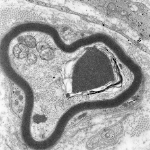Main Article Content
Abstract
Introduction
Neurodegeneration with brain iron accumulation (NBIA) consists of a heterogeneous group of disorders with brain iron accumulation as common radiological endpoint. Mutations in multiple genes have been associated with NBIA. We present 2 cases with a different type of NBIA, in whom the diagnosis was confirmed before brain iron accumulation became evident on MRI.
Case description
The first patient was referred because of frequent falls at the age of 4 years. She had an ataxic gait and weak Achilles tendon reflexes. Two years later, pyramidal and more prominent cerebellar signs became evident. A skin and muscle biopsy revealed intra-axonal spheroids in the peri-and endomysial myelinated nerve bundles as well as in the motor endplates, which led to the diagnosis of PLA2G6-associated neurodegeneration (PLAN). Brain iron accumulation occurred at follow-up MRI at 9 years of age.
The second patient was referred because of developmental stagnation and detection of elevated liver enzymes at 3 months of age. Seizures started at 15 months of age, and were refractory to treatment with multiple anti-epileptic drugs. Molecular genetic testing using an epilepsy gene panel revealed a mutation in the WDR45 gene, a known cause of beta-propeller protein-associated neurodegeneration (BPAN). Brain MRI at 14 months of age showed diffuse hypomyelination in the absence of BIA.
Discussion
This report highlights that NBIA can be suspected on a clinical basis and confirmed by genetic testing before iron accumulation becomes present on brain MRI. Early diagnosis will provide a longer timeframe for potential disease modulating treatments in the future.
Article Details
Copyright (c) 2019 Ine Hoogwijs

This work is licensed under a Creative Commons Attribution-NonCommercial-ShareAlike 4.0 International License.
Authors who publish with this journal agree to the following terms:
Authors retain copyright and grant the journal right of first publication with the work simultaneously licensed under a Creative Commons Attribution License that allows others to share the work with an acknowledgement of the work's authorship and initial publication in this journal.
Authors are able to enter into separate, additional contractual arrangements for the non-exclusive distribution of the journal's published version of the work (e.g., post it to an institutional repository or publish it in a book), with an acknowledgement of its initial publication in this journal.
Authors are permitted and encouraged to post their work online (e.g., in institutional repositories or on their website) prior to and during the submission process, as it can lead to productive exchanges, as well as earlier and greater citation of published work (See The Effect of Open Access).

